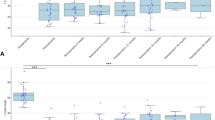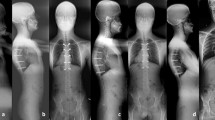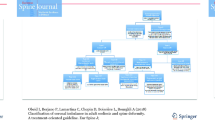Abstract
Purpose
Pedicle screw (PS) placement in thoracic scoliotic deformities can be challenging due to altered vertebral anatomy; malposition can result in severe functional disability or inferior construct stability. Three-dimensional (3D) printed patient-specific guides (PSGs) have been recently used to supplement other PS placement techniques. We conducted a single-center, retrospective observational study to assess the accuracy of PS placement using PSGs in a consecutive case series of pediatric and adult patients with thoracic scoliosis.
Methods
We analyzed the data of patients with thoracic scoliosis who underwent PS placement using 3D-printed PSG as a vertebral cannulation aid between June 2013 and July 2018. PS positions were determined via Gertzbein–Robbins (GR) and Heary classifications on computed tomography images. We determined the concordance of actual and preoperatively planned PS positions and defined the technique learning curve using a receiver-operating characteristic (ROC) curve.
Results
We performed 362 thoracic PS placement procedures in 39 consecutive patients. We classified 352 (97.2%), 2 (0.6%), and 8 (2.2%) screws as GR grades 0 (optimal placement), I, and II, respectively. The average instrumented PS entry point offsets on the X- and Y-axes were both 0.8 mm, and the average differences in trajectory between the planned and the actual screw placements on the oblique sagittal and oblique transverse planes were 2.0° and 2.4°, respectively. The learning process was ongoing until the first 12 PSs were placed.
Conclusions
The accuracy of PS placement using patient-specific 3D templates in our case series exceeds the accuracies of established thoracic PS placement techniques.




Similar content being viewed by others
References
Lenke LG, Kuklo TR, Ondra S, Polly DW (2008) Rationale behind the current state-of-the-art treatment of scoliosis (in the pedicle screw era). Spine 33:1051–1054. https://doi.org/10.1097/BRS.0b013e31816f2865
Davis CM, Grant CA, Pearcy MJ et al (2017) Is there asymmetry between the concave and convex pedicles in adolescent idiopathic scoliosis? A CT investigation. Clin Orthop Relat Res 475:884–893. https://doi.org/10.1007/s11999-016-5188-2
Hicks JM, Singla A, Shen FH, Arlet V (2010) Complications of pedicle screw fixation in scoliosis surgery: a systematic review. Spine 35:E465–E470. https://doi.org/10.1097/BRS.0b013e3181d1021a
Tong Y, Kaplan DJ, Spivak JM, Bendo JA (2020) Three-dimensional printing in spine surgery: a review of current applications. Spine J 20:833–846. https://doi.org/10.1016/j.spinee.2019.11.004
Lopez CD, Boddapati V, Lee NJ et al (2021) Three-dimensional printing for preoperative planning and pedicle screw placement in adult spinal deformity: a systematic review. Glob Spine J 11:936–949. https://doi.org/10.1177/2192568220944170
Liang W, Han B, Hai JJ et al (2021) 3D-printed drill guide template, a promising tool to improve pedicle screw placement accuracy in spinal deformity surgery: a systematic review and meta-analysis. Eur Spine J 30:1173–1183. https://doi.org/10.1007/s00586-021-06739-x
Luo M, Wang W, Yang N, Xia L (2019) Does three-dimensional printing plus pedicle guider technology in severe congenital scoliosis facilitate accurate and efficient pedicle screw placement? Clin Orthop Relat Res 477:1904–1912. https://doi.org/10.1097/CORR.0000000000000739
Lu S, Zhang YZ, Wang Z et al (2012) Accuracy and efficacy of thoracic pedicle screws in scoliosis with patient-specific drill template. Med Biol Eng Comput 50:751–758. https://doi.org/10.1007/s11517-012-0900-1
Garg B, Gupta M, Singh M, Kalyanasundaram D (2019) Outcome and safety analysis of 3D-printed patient-specific pedicle screw jigs for complex spinal deformities: a comparative study. Spine J 19:56–64. https://doi.org/10.1016/j.spinee.2018.05.001
Cecchinato R, Berjano P, Zerbi A et al (2019) Pedicle screw insertion with patient-specific 3D-printed guides based on low-dose CT scan is more accurate than free-hand technique in spine deformity patients: a prospective, randomized clinical trial. Eur Spine J 28:1712–1723. https://doi.org/10.1007/s00586-019-05978-3
Gertzbein SD, Robbins SE (1990) Accuracy of pedicular screw placement in vivo. Spine 15:11–14. https://doi.org/10.1097/00007632-199001000-00004
Heary RF, Bono CM, Black M (2004) Thoracic PSs: postoperative computerized tomography scanning assessment. J Neurol Surg 100:325–331
Goncalves L, Subtil A, Oliveira M et al (2014) ROC curve estimation: an overview. REVSTAT Stat J 12:1–20
Hajian-Tilaki K (2013) Receiver operating characteristic (ROC) curve analysis for medical diagnostic test evaluation. Caspian J Intern Med 4:627–635
Agha RA, Sohrabi C, Mathew G et al (2020) The PROCESS 2020 guideline: updating consensus preferred reporting of case series in surgery (PROCESS) guidelines. Int J Surg 84:231–235. https://doi.org/10.1016/j.ijsu.2020.11.005
Hoo ZH, Candlish J, Teare D (2017) What is an ROC curve? Emerg Med J 34:357–359. https://doi.org/10.1136/emermed-2017-206735
Ledonio CGT, Polly DW Jr, Vitale MG et al (2011) Pediatric pedicle screws: comparative effectiveness and safety: a systematic literature review from the scoliosis research society and the pediatric orthopaedic society of north america task force. J Bone Joint Surg Am 93:1227–1234. https://doi.org/10.2106/JBJS.J.00678
Abul-Kasim K, Ohlin A, Strömbeck A et al (2010) Radiological and clinical outcome of screw placement in adolescent idiopathic scoliosis: evaluation with low-dose computed tomography. Eur Spine J 19:96–104. https://doi.org/10.1007/s00586-009-1203-6
Sarwahi V, Wendolowski SF, Gecelter RC et al (2016) Are we underestimating the significance of pedicle screw misplacement? Spine 41:E548–E555. https://doi.org/10.1097/BRS.0000000000001318
McCormick J, Aebi M, Toby D, Arlet V (2013) Pedicle screw instrumentation and spinal deformities: have we gone too far? Eur Spine J 22(Supplement 2):S216–S224. https://doi.org/10.1007/s00586-012-2300-5
Sharma S, Wu C, Andersen T et al (2013) Prevalence of complications in neuromuscular scoliosis surgery: a literature meta-analysis from the past 15 years. Eur Spine J 22:1230–1249. https://doi.org/10.1007/s00586-012-2542-2
Upendra BN, Meena D, Chowdhury B et al (2008) Outcome-based classification for assessment of thoracic pedicular screw placement. Spine 33:384–390
Valič M, Žižek D, Špan M et al (2020) Malpositioned pedicle screw in spine deformity surgery endangering the aorta: report of two cases, review of literature, and proposed management algorithm. Spine Deform 8:809–817. https://doi.org/10.1007/s43390-020-00094-5
Ughwanogho E, Patel NM, Baldwin KD et al (2012) Computed tomography-guided navigation of thoracic pedicle screws for adolescent idiopathic scoliosis results in more accurate placement and less screw removal. Spine 37:E473–E478. https://doi.org/10.1097/BRS.0b013e318238bbd9
Gang C, Haibo L, Fancai L et al (2012) Learning curve of thoracic pedicle screw placement using the free-hand technique in scoliosis: how many screws needed for an apprentice? Eur Spine J 21:1151–1156
Acknowledgments
We would like to thank Editage (www.editage.com) for English language editing.
Funding
The authors did not receive support from any organization for the submitted work.
Author information
Authors and Affiliations
Corresponding author
Ethics declarations
Conflict of interests
The authors have no relevant financial or non-financial interests to disclose.
Ethics approval
This study was performed in line with the principles of the Declaration of Helsinki. Approval was granted by the Institutional Review Board and Ethics Committee of Valdoltra Orthopedic Hospital (Document No. 1/2017, issued on January 13th, 2017).
Informed consent
Informed consent was obtained from all individual participants included in the study.
Additional information
Publisher's Note
Springer Nature remains neutral with regard to jurisdictional claims in published maps and institutional affiliations.
Rights and permissions
Springer Nature or its licensor (e.g. a society or other partner) holds exclusive rights to this article under a publishing agreement with the author(s) or other rightsholder(s); author self-archiving of the accepted manuscript version of this article is solely governed by the terms of such publishing agreement and applicable law.
About this article
Cite this article
Mohar, J., Valič, M., Podovšovnik, E. et al. Pedicle screw placement safety with the aid of patient-specific guides in a case series of patients with thoracic scoliosis. Eur Spine J 31, 3544–3550 (2022). https://doi.org/10.1007/s00586-022-07427-0
Received:
Revised:
Accepted:
Published:
Issue Date:
DOI: https://doi.org/10.1007/s00586-022-07427-0




